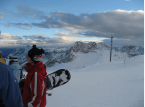
Brandon Cooper > Junior > Journalism > University of Maryland, Photo by Severin St. Martin
Like the burly grizzly bear in the forest, many college students spend their winters inside, hibernating from the winter cold.
This often leads students to neglect the exercise they might participate in during the warm weather. This is especially true for those people who cannot play their sport or exercise inside a gym or indoor arena.
Still, some college clubs and organizations do not wait for the icicles to melt and the flowers to bloom to get out and get moving. Take a look at some options of how to get involved with these winter outdoors clubs:
Skiing & Snowboarding
Since skiing and snowboarding cannot exactly be done in the spring, clubs at numerous universities plan tons of trips during the winter to make sure interested students have the opportunity to hit the slopes.
The clubs will often provide shorter day trips to local mountains around their area, as well as overnight trips to more distant resorts.
The Temple University Snowboarding Club (TUSC) recently returned from a trip to Mont-Tremblant in Canada. For just under $600, 115 students spent a week in Quebec’s Laurentian Mountains, spending their days zooming down the mountain and soaring up the half-pipe.
“There are a lot of organizations on campus that are pretty serious and school is hard, so we just want people to have a good time,” TUSC President George Renda said. Around 150 members of all different levels take advantage of this opportunity to get off campus and have fun.
Caving
Moving from atop the mountain to inside it, another fitting outdoor activity for winter is caving.
“We can do [caving trips] in the cold because it’s 50 degrees in the cave year-round,” said Ben Parker, president of John Hopkins University’s Outdoor Club (JHOC).
JHOC takes students caving at Whiting’s Neck Cave in West Virginia. Students are be repelled into the cave wearing a harness and explore various rooms and areas for the whole day. The excursion is completely free and includes the gear, trained student leaders, and advising necessary to complete the trip safely.
With actives like this, safety is a priority and club leaders make sure that all participants are prepared ahead of time. “Before all of our trips we have a pre-trip meeting and recommend things to bring with you,” Parker said. “We’ll generally advise our participants to wear layers and bring extra clothing.”
Hiking
JHOC also sponsors hiking trips throughout the winter. The trails they visit vary and include the Appalachian Trail and the Billy Goat Trail that passes by Great Falls and the C&O Canal in Maryland.
The hikes are free, just like the caving trips, and also vary on their distance. According to Parker, hike could be between three and seven miles.
No matter the location, the distance or the temperature, the hikes are pretty popular.
“We usually see a lot more sign-ups during the beginning of the semester,” Parker said speaking to appeal of one-day trips that offer a brief respite from college stress. “No one has any mid terms, so we see a good amount of people.”
Joining a Club
Any student interested in finding out if there is a club or organization on their campus specializing in any of these activities usually just needs to find their university’s directory of student clubs and organizations. These directories can almost always be found online.
Once anyone finds these clubs, it’s not very difficult to get involved.
“[The JHOC] constitution says that everyone on campus is in the club,” Parker said.



















